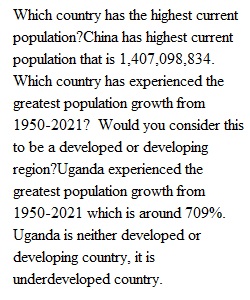


Q Module 3 - Writing Assignment Regional Differences in Human Population Growth Global population has grown exponentially since the Industrial Revolution as advances in medicine, food and agriculture, and public health and sanitation have led to a global decline in the death rate. The writing assignment for this week covers some of the concepts we discussed in the lectures and reading material. This assignment explores the International Data Base (IDB) that provides demographic measures of over 200 countries and areas of the world. The IDB includes a comprehensive set of indicators such as total population, population by age and sex, and demographic characteristics such as fertility, mortality, and migration. Objectives: • Explain historical, current, and future human population growth trends and their consequences. • Interpret age-structure diagrams. Regional Differences in Human Population Growth You are going to compare the population growth and projected population changes for several regions of the world based on continent and level of development. The census data you will need for this assignment is found here: https://www.census.gov/data-tools/demo/idb/#/country?YR_ANIM=2021&menu=countryViz&FIPS_SINGLE=CH&COUNTRY_YEAR=2021 (Links to an external site.) >>>If you prefer to work on a word doc. version of this part, you can download here: World Census Population Comparison by Region-2-1 (2)-1.docx Download World Census Population Comparison by Region-2-1 (2)-1.docx Part I: Population Growth Data for Regions of the World Instructions for accessing regional census data: 1. Click on the Trends by Measure tab to explore an overall picture of the world’s population for different countries from 1990, projected to 2100. 2. Toggle back to the Country Dashboard tab. Under this tab, you can view demographic facts and visuals about the world or individual countries, as well as population age and sex characteristics 3. Under aggregation options, click on the dashboard button (3 lines’ symbol). Under this tab, the world is initially selected. 4. Select the countries/regions listed in the table below: China, Gaza Strip, Germany, Japan, Pakistan, Sudan, Uganda, and United States. 5. For each country/region, record numbers for each perspective year. Under the population graph you can hover over the graph line to find out the population in that country for each specific year. • o I filled out the first row as an example. o When you scroll down the page, you can also see graphs for the country’s annual growth rate, population pyramid, total fertility rate, and life expectancy at Birth by Sex. 6. When you are finished, click the back button and repeat for the next region. 7. Calculate the population % growth from 1950-2021 using this equation: % Population Growth = ((2021 Population – 1950 Population) / 1950 Population) x 100% For the example below (China), this is how the equation looks like: ((1,407,098,834 - 562,580,000)/ 562,580,000) x 100% ~ 150% Complete the table below for each region Region/Country 1950 Population 1970 Population 1990 Population 2021 Population Population % Growth 1950-2021 China 562,580,000 822,116,000 1,153,164,000 1,407,098,834 150% Gaza Strip Germany Japan Pakistan Sudan Uganda United States Part II: Conclusion and Analysis 1. Complete the table above for each region (15 points) 2. Which country has the highest current population? (2 point) 3. Which country has experienced the greatest population growth from 1950-2021? Would you consider this to be a developed or developing region? (4 points) 4. Which country has experienced the lowest population growth from 1950-2021? Would you consider this to be a developed or developing region? (4 points) 5. Use what you know about developed and developing regions to hypothesize why there is such a big difference in growth rate between the countries from question #2 and question #3. (4 points) 6. Compare the population pyramids for these three countries Germany, Uganda, and United States. What does each population pyramid indicate about the future trends of populations for each of these countries? (6) Writing Assignment Rubric Rubric for Assignments.pdf Download Rubric for Assignments.pdf ________________________________________ How to Complete Your Assignment [File Upload Example] Submit your work here in the CANVAS system as a .docx (Word document) or other word processing file. (Google Docs (Links to an external site.) Links to an external site. is also acceptable. Directions to Submit 1. On the right hand Menu, you will see a SUBMIT ASSIGNMENT button with a white plus sign. 2. Click on the SUBMIT ASSIGNMENT Then click BROWSE to look for your file on your computer. 3. When done, click the SUBMIT ASSIGNMENT button. ________________________________________ How to Complete Your Assignment [URL Example] Submit your work here in the CANVAS system as a URL (Web Link). Directions to Submit 1. On the right hand Menu, you will see a SUBMIT ASSIGNMENT button with a white plus sign. 2. Click on the SUBMIT ASSIGNMENT Then enter in your URL. 3. When done, click the SUBMIT ASSIGNMENT button. PreviousNext
View Related Questions